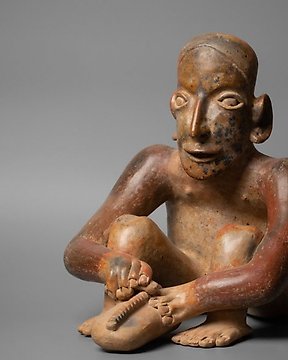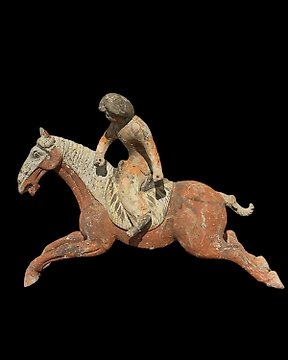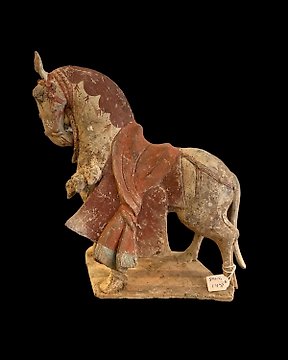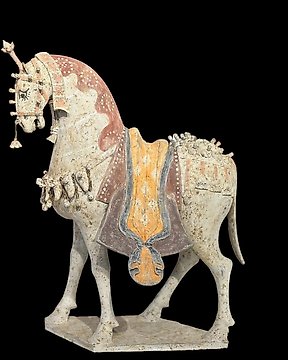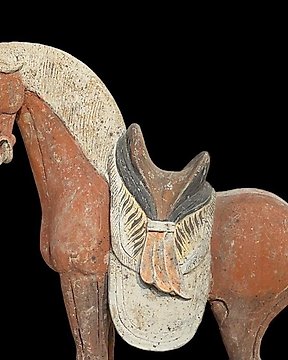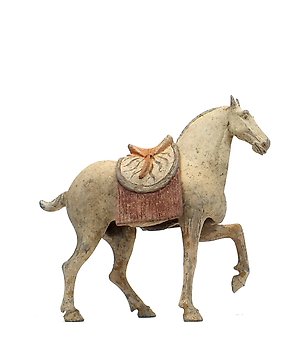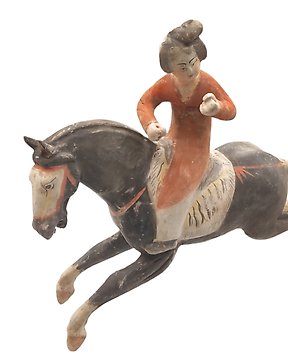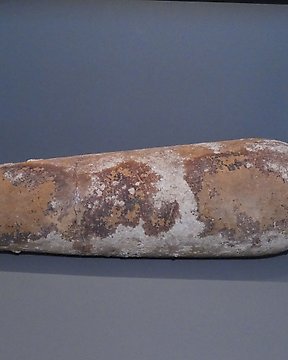Object is beautiful and in good condition Thank you
Se oversættelseDet gamle Kina, Tang-dynastiet Terrakotta TANG Horse - Termoluminescens QED LABORATOIRE - 23 cm
Nr. 85290011





Horse; China, Tang dynasty, 618-906 AD.
Polychrome terracotta.
QED LABORATOIRE thermoluminescence certificate is attached
Measurements: 23x 34 CM
Figure of a horse, made of polychrome terracotta, probably with the usual slips of the time (cold applied), which could have been part of the funerary trousseau of some prominent member of the Tang dynasty. It stands out for the naturalistic way in which the artist has portrayed it, capturing the face in detail and adopting a galloping position, with the head slightly turned. The Tang dynasty is considered by historians to be a period of splendor of Chinese civilization, equal to or even superior to the Han period. Emerging after a period of despotism under the cruel Yang Di, it was established by Li Shimin who, out of filial piety, he put his father on the throne before assuming the role of emperor and founding the Tang dynasty. Spurred by contact with India and the Middle East through the Silk Road, the Tang Empire experienced a creative boom in many fields. Buddhism, which had emerged in India in the time of Confucius, continued to flourish during this period and was adopted by the imperial family, becoming an essential part of traditional Chinese culture. The development of the printing press also expanded the dissemination of written works, giving rise to the golden age of Chinese art and literature, and the great cultural opening resulted in art that was fundamentally colorful, expressive and very eclectic, although it remained mainly with funeral purposes. use, the artist being an anonymous craftsman.
However, from this time onwards, high-fired ceramics, decorated with glazes, would come to be used as a status symbol, with typologies such as vessels for the literary man's table and all types of tableware. Terracotta, for its part, continued to be used for funerary trousseau, although from now on stoneware would also be used, especially for the tombs of nobles and scholars. In funerary pieces, the group to which these bears belong, an important novelty was introduced: tricolor lead glazes (sancai), although pieces decorated with slips continued to be made. Among the funerary trousseau, six typological groups are distinguished, each of them with great variety: tomb guardians, with warriors and protective beasts; ceremonial figures with their servants; animals of all kinds, such as oxen, camels and horses; musicians and court ladies; utensils and vessels; and finally, architectural models. Three periods can also be distinguished. The first of them, between 681 and 683, is dominated by figures decorated with slips, but not yet glazed, so the pieces presented here could date between these years. The second period, between 683 and 779, is the great Sancai period, with enamel predominating. Finally, until the beginning of the 10th century, pieces continued to be made with Sancai enamels, although of lower quality than those of the previous era.
Condition: VERY GOOD
Origin: M.L.F. Private Collection, Madrid. Purchased from an antique dealer in Hong Kong.
Notes: The piece includes a Spanish Export License (Passport for the European Union), at the time of sale it is requested in the name of the buyer, the process takes 2 to 4 weeks. - If the piece is destined for outside the European Union, a replacement of the export permit will be requested. This procedure entails fees that the buyer must pay during the application process. This process can take 4 to 6 weeks. SHIPPED WITH INSURANCE
The transportation price is estimated and ultimately depends on the type of packaging, size and weight of the boxes. The buyer will be informed of the final shipping price and will be asked for the difference or paid the difference.
Important: If the piece travels to Asia, transportation costs may vary significantly due to the current situation.
Important information. The seller guarantees that he has the right to ship this lot.
The seller will ensure that the necessary permits are processed.
The seller will inform the buyer about this if it takes more than a few days
Sælger's Historie
Horse; China, Tang dynasty, 618-906 AD.
Polychrome terracotta.
QED LABORATOIRE thermoluminescence certificate is attached
Measurements: 23x 34 CM
Figure of a horse, made of polychrome terracotta, probably with the usual slips of the time (cold applied), which could have been part of the funerary trousseau of some prominent member of the Tang dynasty. It stands out for the naturalistic way in which the artist has portrayed it, capturing the face in detail and adopting a galloping position, with the head slightly turned. The Tang dynasty is considered by historians to be a period of splendor of Chinese civilization, equal to or even superior to the Han period. Emerging after a period of despotism under the cruel Yang Di, it was established by Li Shimin who, out of filial piety, he put his father on the throne before assuming the role of emperor and founding the Tang dynasty. Spurred by contact with India and the Middle East through the Silk Road, the Tang Empire experienced a creative boom in many fields. Buddhism, which had emerged in India in the time of Confucius, continued to flourish during this period and was adopted by the imperial family, becoming an essential part of traditional Chinese culture. The development of the printing press also expanded the dissemination of written works, giving rise to the golden age of Chinese art and literature, and the great cultural opening resulted in art that was fundamentally colorful, expressive and very eclectic, although it remained mainly with funeral purposes. use, the artist being an anonymous craftsman.
However, from this time onwards, high-fired ceramics, decorated with glazes, would come to be used as a status symbol, with typologies such as vessels for the literary man's table and all types of tableware. Terracotta, for its part, continued to be used for funerary trousseau, although from now on stoneware would also be used, especially for the tombs of nobles and scholars. In funerary pieces, the group to which these bears belong, an important novelty was introduced: tricolor lead glazes (sancai), although pieces decorated with slips continued to be made. Among the funerary trousseau, six typological groups are distinguished, each of them with great variety: tomb guardians, with warriors and protective beasts; ceremonial figures with their servants; animals of all kinds, such as oxen, camels and horses; musicians and court ladies; utensils and vessels; and finally, architectural models. Three periods can also be distinguished. The first of them, between 681 and 683, is dominated by figures decorated with slips, but not yet glazed, so the pieces presented here could date between these years. The second period, between 683 and 779, is the great Sancai period, with enamel predominating. Finally, until the beginning of the 10th century, pieces continued to be made with Sancai enamels, although of lower quality than those of the previous era.
Condition: VERY GOOD
Origin: M.L.F. Private Collection, Madrid. Purchased from an antique dealer in Hong Kong.
Notes: The piece includes a Spanish Export License (Passport for the European Union), at the time of sale it is requested in the name of the buyer, the process takes 2 to 4 weeks. - If the piece is destined for outside the European Union, a replacement of the export permit will be requested. This procedure entails fees that the buyer must pay during the application process. This process can take 4 to 6 weeks. SHIPPED WITH INSURANCE
The transportation price is estimated and ultimately depends on the type of packaging, size and weight of the boxes. The buyer will be informed of the final shipping price and will be asked for the difference or paid the difference.
Important: If the piece travels to Asia, transportation costs may vary significantly due to the current situation.
Important information. The seller guarantees that he has the right to ship this lot.
The seller will ensure that the necessary permits are processed.
The seller will inform the buyer about this if it takes more than a few days
Sælger's Historie
- 3
- 1
- 0
Received my parcel in great condition. Very well taken care of. Thank you!
Se oversættelseTrès bel objet, livré dans l'appartement, parfait
Se oversættelseA embalagem era desadequada porque não garantiu a preservação da peça. Verficou-se a quebra de uma parte da peça.
Se oversættelse- 3
- 1
- 0
Object is beautiful and in good condition Thank you
Se oversættelse